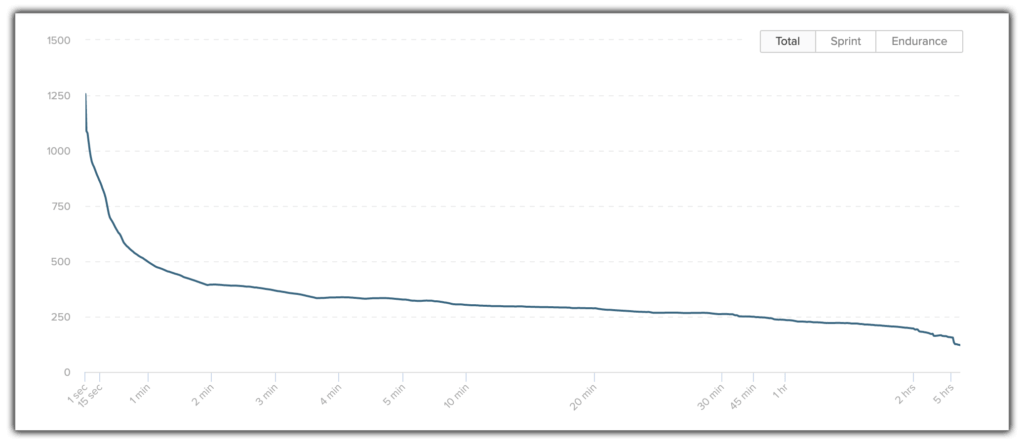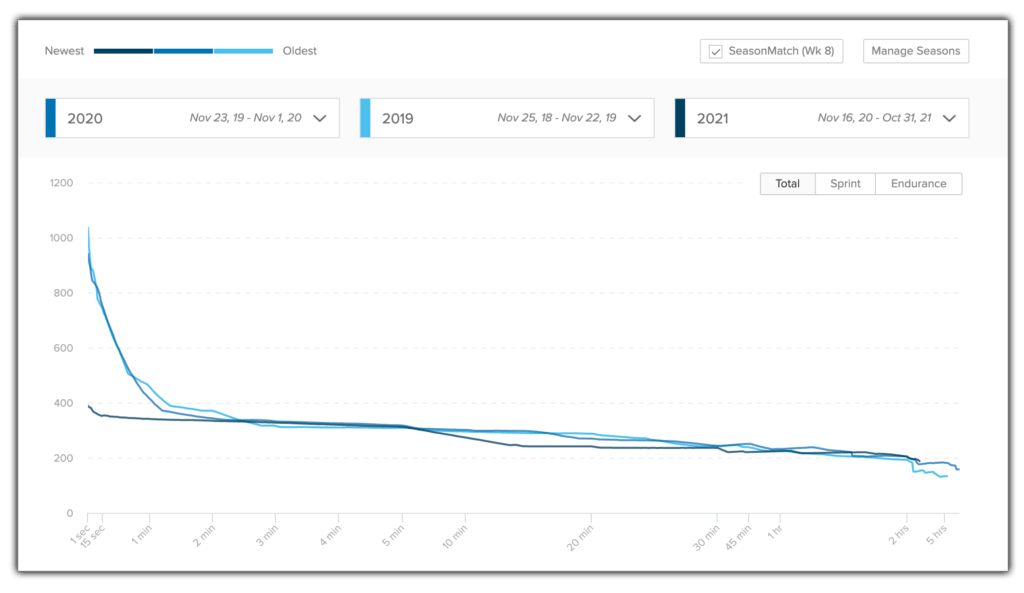How Your Cycling Power Curve Can Help You Get Faster And Win Races

Every cyclist knows time and intensity are intertwined. For example, It’s almost impossible to sprint for more than a few seconds, but easy endurance riding can be sustained for many hours with proper fueling. This connection is called a power curve, and examining it can offer important insights into your relative strengths and weaknesses. But like other cycling metrics, it can also be misleading if not considered with the proper context. Let’s examine what a power curve can (and can’t) reveal.
For more training and cycling related tips check out Ask a Cycling Coach Podcast Episode 291.
What is a Cycling Power Curve?
A power curve is a visual depiction of the maximum power a cyclist has generated over time, represented as a line graph. The graph’s X axis is time, and the Y axis shows cycling power in watts. Since hard efforts can only be sustained for short periods, power curves generally slope downwards to the right.

Power curves can be created for individual workouts, or they can aggregate the best efforts from multiple rides or even entire seasons. Since it’s hard to do more than a few truly maximal efforts during a single workout, long-term power curves can be an accurate way to capture your overall capabilities, since they combine best efforts from multiple rides. Long-term power curves tend to look a bit like a hockey stick, with a steep downward slope over the first few minutes and a much flatter line over the course of several hours.
In TrainerRoad, power curves are displayed as Personal Records charts. These graphs are available individually for each completed workout in the Calendar, as well as for longer time durations under the Career menu.
What Can You Learn From Your Power Curve?
The simplest use of your power curve is to suggest how long you can sustain a given intensity. This can be useful in any situation requiring pacing, such as a time trial, Strava segment, or mid-race climb. By comparing the expected duration of the effort with your recent capabilities for that length of time, you can quickly develop a pacing strategy that keeps you from going too hard in the heat of the moment.
Power curves are also very useful for watching your abilities change over time. By comparing power curves from successive seasons, for instance, you can see a visual representation of how your capabilities measure up to your previous best performances.
Finally, power curves can also help you identify your relative strengths and weaknesses. Steady, sustained power curves can indicate a natural affinity for time-trialing, while very high sustained power for 15 or 30 seconds suggests a gift for sprinting. Knowing what type of efforts you are best at can help you identify opportunities to win races, and knowing your weaknesses can help you target your training.
Further Reading on Power Curves and Personal Records Analysis
What your Power Curve Can’t Tell you
While your power curve can help guide your racing strategy, many cyclists overinterpret their power curves as a sort of cycling destiny, anointing themselves sprinters or climbers and allowing these self-imposed labels to dictate their riding. Don’t fall into this common trap! At the professional level, this type of specialization is useful, but for most amateur racers power curves don’t predict your potential as an athlete. You don’t have to be a “sprinter” to win a sprint.
Limited to What You’ve Done
Crucially, your power curve is limited in that it only reflects riding you’ve actually done. Power curves make no assumptions about what you could do, given the chance. This means that very often, your power curve may not accurately reflect or predict your actual potential.
One reason has to do with the composition of your recent workouts. If you haven’t done any maximal efforts in the timeframe your power curve depicts, it’s safe to assume that almost any point on the curve is an underestimation of your abilities. This is particularly true during early season Base Training. Since these training plans include few high-intensity workouts, a power curve from this period won’t reflect any maximal efforts.
Not the Whole Picture
It’s best to think of a power curve as a “greatest hits” collection of your personal bests. Power curves are most useful and accurate when they include a variety of indoor and outdoor workouts, and especially if they include recent races and maximal efforts. But even then, they fail to account for other important factors such as repeatability, technical skills, confidence, and racecraft. Most disciplines of cycling are more than simple power contests, so while your power curve can reveal a lot about your ability to turn pedals, it rarely captures your true potential as a competitor.
Adaptive Training
Get the right workout, every time with training that adapts to you.
Check Out TrainerRoadUsing your Power Curve to Get Faster and Win Races
Now that we’ve established what your power curve can and can’t reveal, let’s take a look at a few specific ways that you can use it to your advantage in training and in competition.
Tracking Personal Records with SeasonMatch
SeasonMatch is a powerful tool included in TrainerRoad’s Personal records chart, allowing you to compare power curves from the same point in multiple seasons. Comparing the same calendar dates from year to year often doesn’t tell the entire story, since training may begin at a different time each year; SeasonMatch allows for fairer comparisons of your progress over time as you follow a structured training plan. Click here for instructions on how to use SeasonMatch.

Target Race Demands in Training
Some race courses and disciplines require sustained power for specific lengths of time. For example, a 15 minute climb in the middle of an otherwise flat road race is likely to be a deciding factor in the fight for the podium. If research into your event reveals such a specific obstacle, you can use your power curve to help train for it. Practice efforts of an equivalent length and intensity, and use your power curve to monitor your progress. Keep in mind that on race day, the cumulative effect of hard efforts before and after the key terrain feature can be decisive too, so use your power curve to monitor your endurance for longer than only what the individual challenge requires.
Identify Opportunities
Watching your power curve over time will likely reveal natural strengths and weaknesses, and you can use this knowledge to find opportunities to make a race work in your favor. If your power curve reveals a superior 5 minute power, attack on a 5-minute climb. If you’re a strong sprinter, work to keep the breakaway from sticking so the race comes down to a bunch finish. By making the race fit your power curve, you can increase your odds for success, while keeping your options open if things don’t go your way.
